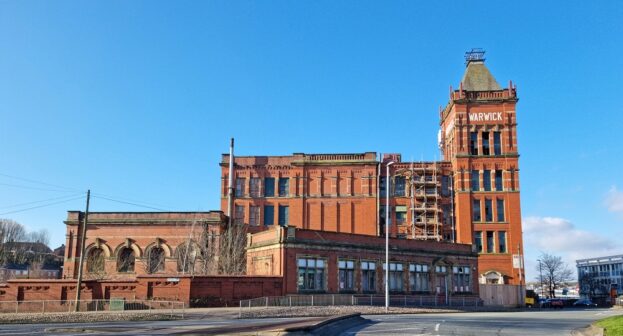
The relationship between the UK cotton mills and slavery is a central aspect of Britain’s industrial history, intertwined in the widespread cultivation and processing of cotton in the 18th and 19th centuries. This period was characterised by remarkable progress in technology and trade but also marked by a brutal and exploitative slave system, aspects of history that are often treated separately but are inextricably linked.

British Textile Industry and the Industrial Revolution
Before the Industrial Revolution, the British textile industry was primarily dependent on wool and linen. Inventions such as the spinning jenny, the water frame, and the power loom, however, revolutionised the industry by making cotton a far more desirable fabric. Its adaptability, strength, and suitability for mass production, combined with these technological advancements, created an insatiable demand for raw cotton.
Slave-Grown Cotton
To satiate this burgeoning demand, Britain turned to the American South, where the hot, humid climate and large tracts of arable land were ideal for cotton cultivation. But the cotton wasn’t tended by free men and women; instead, it was grown and harvested by enslaved Africans. They had been captured in their homeland, endured the horrific middle passage across the Atlantic, and were forced to live and work under brutal, degrading conditions in the American South.
This large-scale exploitation formed the backbone of the Atlantic Slave Trade, a system marked by its sheer inhumanity. The suffering endured by these millions of enslaved people powered the economic engine of the American South, which in turn fuelled the booming British cotton industry.
Legislative Changes and Continued Dependence
While Britain was profiting from this brutal system, public sentiment began to shift. The abolitionist movement grew strong, leading to the UK abolishing the slave trade in 1807 with the Slave Trade Act. The Slavery Abolition Act of 1833 further outlawed slavery in most British colonies.
However, these changes did not sever the economic ties Britain had with the institution of slavery. Despite the legislations, British merchants continued to buy slave-grown cotton from America. The mills kept spinning, the factories kept producing, and the British economy thrived, all while profiting from a supply chain rooted in human exploitation.
The American Civil War and the Cotton Famine
The intricate connection between the British cotton mills and American slavery was vividly exposed during the American Civil War (1861-1865). The Union blockade of Confederate ports disrupted the cotton supply to British mills, resulting in the Lancashire Cotton Famine. This had a devastating impact on the mill workers in Lancashire, many of whom lost their jobs as mills were forced to reduce their operations or shut down due to the cotton shortage.
Remarkably, despite the suffering they endured, many mill workers empathised with the Union cause. They championed the abolition of slavery, a testament to the human capacity for empathy amidst hardship.
Legacy and Reckoning with the Past
The legacy of this period is multifaceted. The cotton mills played a significant role in Britain’s industrialisation, brought substantial economic growth, and eventually led to improvements in living standards. On the other hand, this prosperity was built, in part, on the horrific exploitation of enslaved Africans.
The understanding and acknowledgment of this complex history have grown in recent years, fuelled by a broader discussion about the role of slavery in Britain’s past. Efforts are being made to recognise and teach this history, acknowledging that the legacy of slavery continues more fully.
